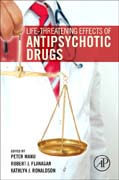
Life-Threatening Effects of Antipsychotic Drugs
Manu, Peter
Flanagan, Robert J.
Ronaldson, Kathlyn J.
Life-Threatening Effects of Antipsychotic Drugs identifies the most common life threatening effects associated with antipsychotics, their incidence and mortality rate, how to identify when these effects may start to occur, and how to treat them if they do occur. The book also discusses the overall cost-benefit ratio of risk relative to quality-of-life outcomes should the risks not occur. Antipsychotic medications have been in use for a long time primarily for schizophrenia and bipolar disorder, but are increasingly being used for other disorders such as obsessive-compulsive disorder, PTSD, personality disorders, Tourette syndrome, autism, and dementia. While clinicians tend to be well-versed in the more common, milder side effects associated with these drugs, the drugs also may result in life-threatening side effects about which clinicians are less aware. Identifies the most common life threatening effects associated with antipsychoticsAdvises what signs to look for in patients who might be experiencing these LTEsDiscusses how to prevent LTEs, or treat them if they do occurProvides incidence, mortality, and time factor when risks are highestIncludes a risk-benefit discussion of side effects vs. quality-of-life improvement INDICE: Anti-Psychotic-Related Deaths: Clinical and Ethical ChallengesAgranulocytosis Myocarditis Pulmonary Embolism Pancreatitis Gastrointestinal Hypomotility Neuroleptic Malignant SyndromeSerotonin Syndrome Hyponatremia SeizuresQTc Prolongation and Torsades de Pointes Diabetic Ketoacidosis Laryngospastic Dystonia Managing the Risk of Life-Threatening Adverse Drug Effects
- ISBN: 978-0-12-803376-0
- Editorial: Academic Press
- Encuadernacion: Cartoné
- Páginas: 384
- Fecha Publicación: 01/08/2016
- Nº Volúmenes: 1
- Idioma: Inglés
